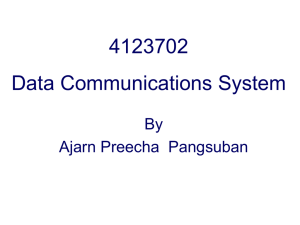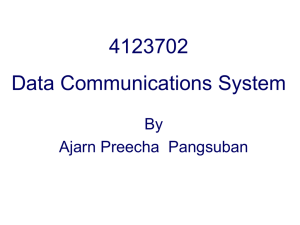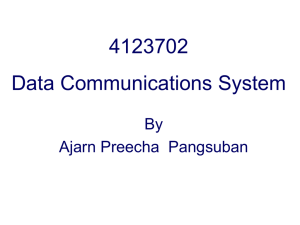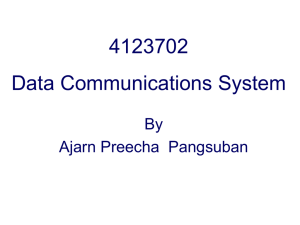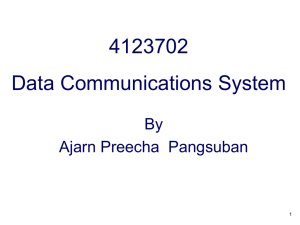ch4-Digital Transmis..
advertisement
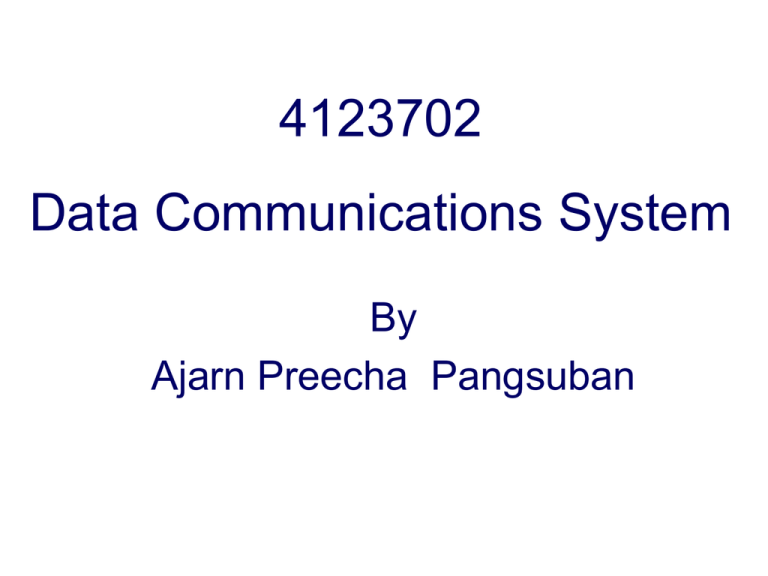
4123702 Data Communications System By Ajarn Preecha Pangsuban Chapter 4 – Digital Transmission Digital Transmission Methods to transmit data digitally Line coding Block coding Sampling Transmission modes Parallel Serial Synchronous Asynchronous 4123702 Data Communications System @YRU 3 Digital Signals Digital – have a limited number of defined values Use binary (0s and 1s) to encode information Less affected by interference (noise); fewer errors 4123702 Data Communications System @YRU 4 4.1 Line Coding Process of converting binary data to a digital signal 4123702 Data Communications System @YRU 5 Line Coding Characteristics Signal Level versus Data Level Pulse Rate versus Bit Rate DC Components Self-Synchronization 4123702 Data Communications System @YRU 6 Signal Level versus Data Level Signal level – number of different values allowed in a signal Data level – number of symbols used to represent data b.Three signal levels, two data levels 4123702 Data Communications System @YRU 7 Pulse Rate versus Bit Rate Pulse rate – defines number of pulses per second Pulse – minimum amount of time required to transmit a symbol Bit rate – defines number of bits per second Bit rate = Pulse rate × log 2 L When L is the number of data level of the signal 4123702 Data Communications System @YRU 8 Example 1 A signal has two data levels with a pulse duration of 1 ms. We calculate the pulse rate and bit rate as follows: 1 Pulse Rate = 110 3 Bit Rate = 1000 pulses/s = Pulse Rate × log2 L = 1000 × log2 2 = 1000 bps 4123702 Data Communications System @YRU 9 Example 2 A signal has four data levels with a pulse duration of 1 ms. We calculate the pulse rate and bit rate as follows: Pulse Rate = Bit Rate 1 110 3 = 1000 pulses/s = Pulse Rate × log2 L = 1000 × log2 4 = 2000 bps 4123702 Data Communications System @YRU 10 DC Components Residual direct-current (dc) components or zero frequencies are undesirable Some systems do not allow passage of a dc component (such as a transformer); may distort the signal and create output errors DC component is extra energy residing on the line and is useless 4123702 Data Communications System @YRU 11 DC Component 4123702 Data Communications System @YRU 12 Self-Synchronization Digital signal includes timing information in the data being transmitted to prevent misinterpretation Figure 4.16 Lack of synchronization 4123702 Data Communications System @YRU 13 Example 3 In a digital transmission, the receiver clock is 0.1 percent faster than the sender clock. How many extra bits per second does the receiver receive if the data rate is 1 Kbps? How many if the data rate is 1 Mbps? Solution At 1 Kbps: 1000 bits sent 1001 bits received1 extra bps At 1 Mbps: 1,000,000 bits sent 1,001,000 bits received1000 extra bps 4123702 Data Communications System @YRU 14 Line Coding Schemes 4123702 Data Communications System @YRU 15 Unipolar Simplest method; inexpensive Uses only one voltage level Polarity (+ or -) is usually assigned to binary 1; a 0 is represented by zero voltage 4123702 Data Communications System @YRU 16 Unipolar Potential problems: DC component Lack of synchronization 4123702 Data Communications System @YRU 17 Polar Uses two voltage levels, one positive and one negative Alleviates DC component Variations Nonreturn to zero (NRZ) Return to zero (RZ) Manchester Differential Manchester 4123702 Data Communications System @YRU 18 Nonreturn to Zero (NRZ) Value of signal is always positive or negative NRZ-L (NRZ-Level) Signal level depends on bit represented; positive usually means 0, negative usually means 1 Problem : synchronization of long streams of 0s or 1s NRZ-I (NRZ-Invert) Inversion of voltage represents a 1 bit 0 bit represented by no change Allows for synchronization 4123702 Data Communications System @YRU 19 NRZ-L and NRZ-I Encoding 4123702 Data Communications System @YRU 20 Return to Zero (RZ) In NRZ-I, long strings of 0s may still be a problem May include synchronization as part of the signal for both 1s and 0s How? Must include a signal change during each bit Uses three values: positive, negative, and zero 1 bit represented by positive-to-zero 0 bit represented by negative-to-zero 4123702 Data Communications System @YRU 21 RZ Encoding 4123702 Data Communications System @YRU 22 RZ Encoding Disadvantage Requires two signal changes to encode each bit; more bandwidth necessary 4123702 Data Communications System @YRU 23 Manchester Uses an inversion at the middle of each bit interval for both synchronization and bit representation Negative-to-positive represents binary 1 Positive-to-negative represents binary 0 Achieves same level of synchronization with only two levels of amplitude 4123702 Data Communications System @YRU 24 Manchester Encoding 4123702 Data Communications System @YRU 25 Differential Manchester Inversion at middle of bit interval is used for synchronization Presence or absence of additional transition at beginning of interval identifies the bit Transition means binary 0; no transition means 1 Requires two signal changes to represent binary 0 but only one to represent 1 4123702 Data Communications System @YRU 26 Differential Manchester 4123702 Data Communications System @YRU 27 Bipolar Encoding Uses three voltage levels: positive, negative, and zero Zero level represents binary 0; 1s are represented with alternating positive and negative voltages, even when the 1 bits are not consecutive Two schemes Alternate mark inversion (AMI) Bipolar n-zero substitution (BnZS) 4123702 Data Communications System @YRU 28 Bipolar AMI Neutral, zero voltage represents binary 0 Binary 1s represented by alternating positive and negative voltages 4123702 Data Communications System @YRU 29 Bipolar n-zero substitution (BnZS) Solves problem of synchronizing sequential 0s, often occurring in long-distance transmission If n consecutive zeros occur, some of the bits in those n bits become positive or negative Substitution violates rules of AMI in a manner that receiver knows the bits are actually 0s and not 1s 4123702 Data Communications System @YRU 30 Other Schemes 2B1Q (two binary, one quaternary) uses four voltage levels One pulse can represent 2 bits; more efficient 4123702 Data Communications System @YRU 31 Other Schemes MLT-3 (multi-line transmission, three level) – similar to NRZ-I using three levels of signals; signal transitions occur at beginning of 1 bit, no transition at beginning of 0 4123702 Data Communications System @YRU 32 4.2 Block Coding Coding method to ensure synchronization and detection of errors Three steps: division, substitution, and line coding 4123702 Data Communications System @YRU 33 Steps in Transformation Step 1 Step 2 Step 3 4123702 Data Communications System @YRU 34 Transformation Steps Step 1: bit stream is divided into groups of m bits Step 2: substitute an m-bit code for an n-bit group Codes with no more than three consecutive 0s or 1s are used to achieve synchronization Since only a subset of blocks are used, if one or more bits are changed and an invalid code is received, a receiver can easily detect the error Step 3: line encoding scheme is then used to create the signal 4123702 Data Communications System @YRU 35 Common Block Codes 4B/5B – every 4 bits of data is encoded into a 5- bit code; NRZ-1 is usually used for line coding 8B/10B – group of 8 bits of data is substituted by a 10-bit code 8B/6T – each 8-bit group is substituted with a sixsymbol code; uses less bandwidth since three signal levels may be used 4123702 Data Communications System @YRU 36 Figure 4.16 Substitution in block coding 4123702 Data Communications System @YRU 37 Table 4.1 4B/5B encoding Data Code Data Code 0000 11110 1000 10010 0001 01001 1001 10011 0010 10100 1010 10110 0011 10101 1011 10111 0100 01010 1100 11010 0101 01011 1101 11011 0110 01110 1110 11100 0111 01111 1111 11101 4123702 Data Communications System @YRU 38 Table 4.1 4B/5B encoding (Continued) Data Code Q (Quiet) 00000 I (Idle) 11111 H (Halt) 00100 J (start delimiter) 11000 K (start delimiter) T (end delimiter) S (Set) 10001 01101 11001 R (Reset) 00111 4123702 Data Communications System @YRU 39 Figure 4.17 Example of 8B/6T encoding 4123702 Data Communications System @YRU 40 4.3 Sampling Analog data must often be converted to digital format (ex: long-distance services, audio) Sampling is process of obtaining amplitudes of a signal at regular intervals 4123702 Data Communications System @YRU 41 Pulse Amplitude Modulation (PAM) Analog signal’s amplitude is sampled at regular intervals; result is a series of pulses based on the sampled data Pulse Coded Modulation (PCM) is then used to make the signal digital 4123702 Data Communications System @YRU 42 Note: Pulse amplitude modulation has some applications, but it is not used by itself in data communication. However, it is the first step in another very popular conversion method called pulse code modulation. 4123702 Data Communications System @YRU 43 Pulse Coded Modulation (PCM) First quantizes PAM pulses; an integral value in a specific range to sampled instances is assigned Each value is then translated to its 7-bit binary equivalent Binary digits are transformed into a digital signal using line coding 4123702 Data Communications System @YRU 44 Figure 4.19 Quantized PAM signal 4123702 Data Communications System @YRU 45 Figure 4.20 Quantizing by using sign and magnitude 4123702 Data Communications System @YRU 46 Figure 4.21 PCM 4123702 Data Communications System @YRU 47 Digitization of an Analog Signal 4123702 Data Communications System @YRU 48 Sampling Rate: Nyquist Theorem Accuracy of digital reproduction of a signal depends on number of samples Nyquist theorem: number of samples needed to adequately represent an analog signal is equal to twice the highest frequency of the original signal 4123702 Data Communications System @YRU 49 Note: According to the Nyquist theorem, the sampling rate must be at least 2 times the highest frequency. 4123702 Data Communications System @YRU 50 Figure 4.23 Nyquist theorem 4123702 Data Communications System @YRU 51 Note: Note that we can always change a band-pass signal to a low-pass signal before sampling. In this case, the sampling rate is twice the bandwidth. 4123702 Data Communications System @YRU 52 Example 4 What sampling rate is needed for a signal with a bandwidth of 10,000 Hz (1000 to 11,000 Hz)? Solution The sampling rate must be twice the highest frequency in the signal: Sampling rate = 2 x (11,000) = 22,000 samples/s 4123702 Data Communications System @YRU 53 Example 5 (How many bit per sample) A signal is sampled. Each sample requires at least 12 levels of precision (+0 to +5 and -0 to -5). How many bits should be sent for each sample? Solution We need 4 bits; 1 bit for the sign and 3 bits for the value. A 3-bit value can represent 23 = 8 levels (000 to 111), which is more than what we need. A 2-bit value is not enough since 22 = 4. A 4-bit value is too much because 24 = 16. 4123702 Data Communications System @YRU 54 Example 6 (Bit rate) We want to digitize the human voice. What is the bit rate, assuming 8 bits per sample? Solution The human voice normally contains frequencies from 0 to 4000 Hz. Sampling rate = 4000 x 2 = 8000 samples/s Bit rate = sampling rate x number of bits per sample = 8000 x 8 = 64,000 bps = 64 Kbps 4123702 Data Communications System @YRU 55 4.4 Transmission Mode 4123702 Data Communications System @YRU 56 Parallel Transmission Bits in a group are sent simultaneously, each using a separate link n wires are used to send n bits at one time Advantage: speed Disadvantage: cost; limited to short distances 4123702 Data Communications System @YRU 57 Serial Transmission Transmission of data one bit at a time using only one single link Advantage: reduced cost Disadvantage: requires conversion devices Methods: Asynchronous Synchronous 4123702 Data Communications System @YRU 58 Asynchronous Transmission Transfer of data with start and stop bits and a variable time interval between data units Timing is unimportant Start bit alerts receiver that new group of data is arriving Stop bit alerts receiver that byte is finished Synchronization achieved through start/stop bits with each byte received 4123702 Data Communications System @YRU 59 Asynchronous Transmission 4123702 Data Communications System @YRU 60 Asynchronous Transmission Requires additional overhead (start/stop bits) Slower Cheap and effective Ideal for low-speed communication when gaps may occur during transmission (ex: keyboard) 4123702 Data Communications System @YRU 61 Synchronous Transmission 4123702 Data Communications System @YRU 62 Synchronous Transmission Requires constant timing relationship Bit stream is combined into longer frames, possibly containing multiple bytes Any gaps between bursts are filled in with a special sequence of 0s and 1s indicating idle Advantage: speed, no gaps or extra bits Byte synchronization accomplished by data link layer 4123702 Data Communications System @YRU 63 Credits All figures obtained from publisher-provided instructor downloads Data Communications and Networking, 3rd edition by Behrouz A. Forouzan. McGraw Hill Publishing, 2004 4123702 Data Communications System @YRU 64
